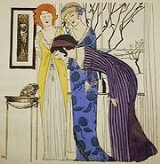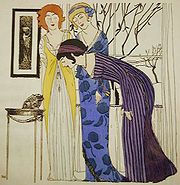
Paul Iribe
Encyclopedia

Early Life and Career
Paul Iribarnegaray was born in Angoulême, France in 1883, of Basque parentage.Iribe received his education in Paris. From 1908 to 1910 he studied at the École des Beaux-Arts
École des Beaux-Arts
École des Beaux-Arts refers to a number of influential art schools in France. The most famous is the École nationale supérieure des Beaux-Arts, now located on the left bank in Paris, across the Seine from the Louvre, in the 6th arrondissement. The school has a history spanning more than 350 years,...
and the College Rollin. In his early twenties he became an apprentice printer at Le Temps
Le Temps
Founded in 1998, Le Temps is a Swiss newspaper edited in French. Le Temps consists of a daily newspaper , several supplements , thematic special editions, a performing website and digital applications.Le Temps is the...
newspaper, and from 1900, he submitted dozens of illustrations and caricature
Caricature
A caricature is a portrait that exaggerates or distorts the essence of a person or thing to create an easily identifiable visual likeness. In literature, a caricature is a description of a person using exaggeration of some characteristics and oversimplification of others.Caricatures can be...
s to such French satirical papers as Rire, Sourire, and L'Assiette au beurre.
Iribe's design career was a prolific one, contributing text and visuals to Vogue magazine, designing fabrics, furniture, rugs and doing interior design work for wealthy clients. Iribe’s work is primarily distinguished by the illustrations he executed for style journals such as La Gazette du Bon Ton, where his charming vignettes of the latest modes helped promote the designs of couturiers such as Paul Poiret. Iribe was one of a talented group of like illustrators including George Barbier, George Lepape, George Martin, and Pierre Brissaud. Their modernist style, informed by both the vitality of the revolutionary art movements of the era, and by the flat, minimalism of Japanese painting served to revitalize the popularity of the “fashion plate.” These “fashion plates” were hand colored using the pochoir process, whereby stencils and metal plates are used allowing for colors to be built up and gradually nuanced according to the artist’s vision. The “fashion plate,” in use for some time, was in essence an advertising tool—a piece of artwork used to create desire for the newest clothing looks aimed at an audience of the fashionable and moneyed. Capitalizing on his prodigious multi-talents, Iribe later used Poiret’s fashions to illustrate a book of erotic drawings, which gained wide popularity.
In 1915, Iribe went to Hollywood to work in the film industry, significantly for Cecil B. DeMille. Iribe served as art director for DeMille’s 1923 production, The Ten Commandments. In Hollywood, Iribe’s design talents were demonstrated in various capacities. His film credits reveal that at one time or another, Iribe worked as costume designer, art director, and production designer on various projects.
Private life
Iribe was part of a Parisian, bohemian clique, a cosmopolitan mix of personalities from the world of the arts and elite society. Notable members were Misia Sert, her husband, Spanish painter, José-Maria Sert, Jean Cocteau and his lover, French actor, Jean Marais, Serge Lifar, a member of the Diaghilev ballet, and couturier, Coco Chanel. It was a libertine group rife with emotional intrigues—all fueled by drug use and abuse. [4] Iribe’s involvement with Coco Chanel was particularly intense. Chanel found Iribe’s provocative wit and professional drive matched her own. Theirs was a romantic liaison, and a bond of like souls who shared the same right-wing politics. Iribe re-figured his newsletter Le Témoin, into a political polemic, whose publication Chanel financed. In the 1930s, Le Témoin was an ultra-nationalist voice, fueling an irrational fear of foreigners and preaching anti-Semitism. It was a diluted echo of the French fascist press. [5]Hal Vaughn’s book, Sleeping With The Enemy, Coco Chanel’s Secret War, shows a re-production of one of Iribe’s illustrations for Le Témoin. In it Chanel, her figure standing in for the iconic, French, feminine symbol for liberty, Marianne, lies nude, stretched out in a faint, surrounded by dark, funereal figures. These menacing “outsiders,” are portrayed as an aggregate of the stereotypical “hook-nosed Jew,” with France at their mercy.
Marriages
- Jeanne Dirys, vaudeville performer: 1911-1918 (divorced)
- Maybelle Hogan, American heiress: 1928-1931 (separated); two children: Pablo, b. 1920, Maybelle, b. 1928
Death
Iribe was with Coco Chanel, at her villa, La Pausa, on the French Riviera in September of 1935, when he suddenly collapsed and died while playing tennis. Chanel witnessed his death, and felt his loss deeply. She grieved for an extended period of time.Works
- Les robes de Paul Poiret, by Paul Iribe. Published by Se trouve a Paris chez Paul Poiret, couturier, 1908.
- Le Témoin..., edited by Paul Iribe. Published by Le Témoin, 1933.
- Bleu, blanc, rouge: France, by Paul Iribe. Published by Etablissements Nicolas.
- Paul Iribe – Précurseur de l'art déco, Published by Bibliothèque Forney, 1983, ISBN 2701205727

